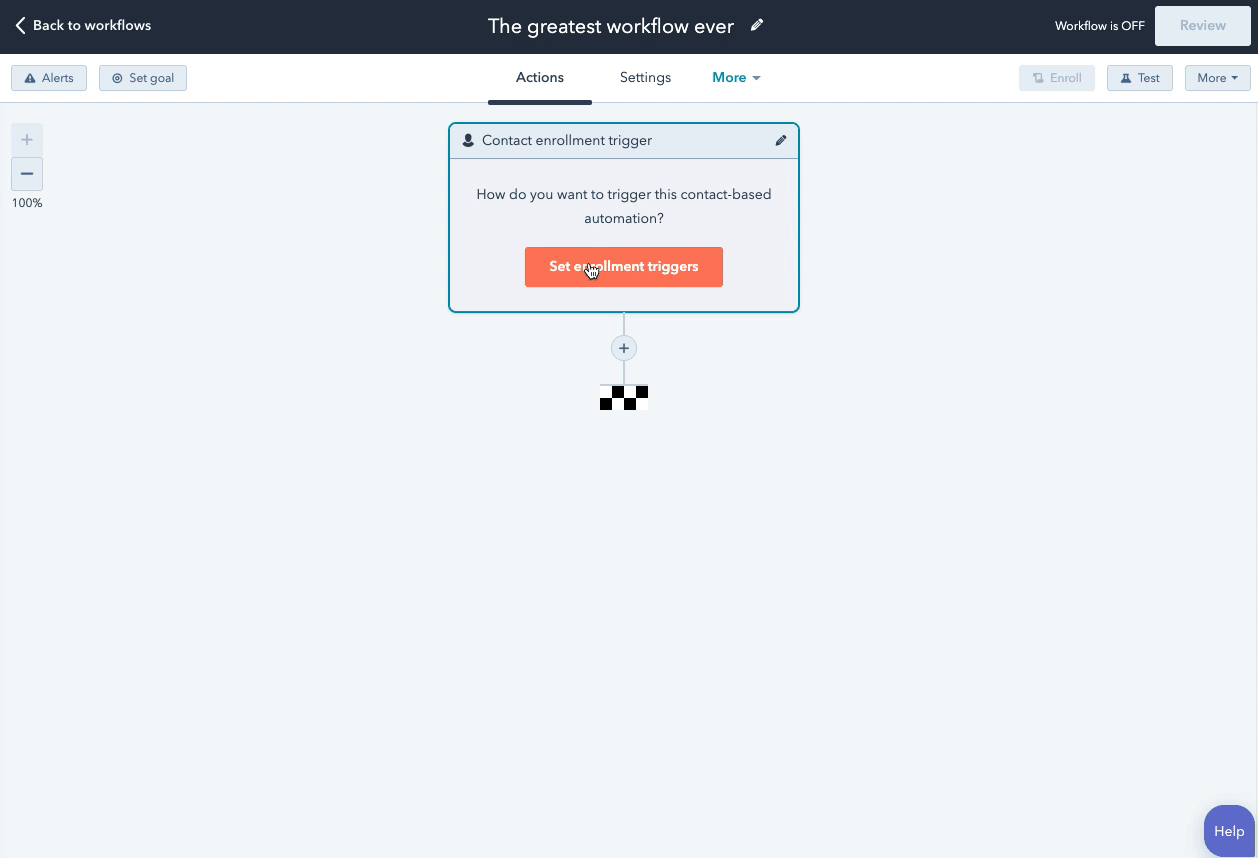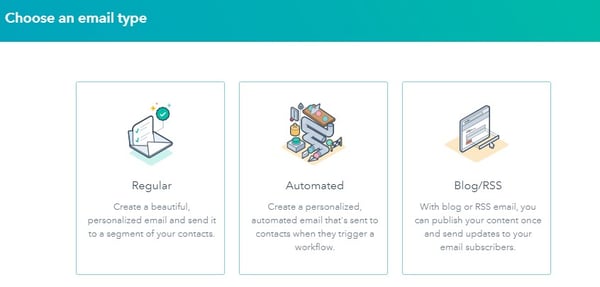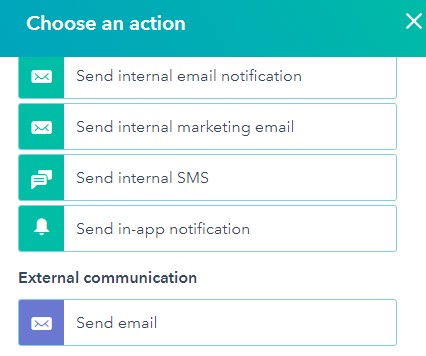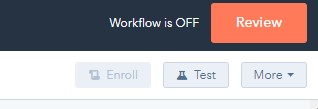Are your contacts going with the flow, or are they just sitting dormant in your marketing database? If you don’t have any automated email workflows set up, your answer is probably the latter — which means you’re missing out on some major opportunities to nurture and engage your existing contacts.
Did you know that marketing automation can lead to a 14.5% increase in sales productivity?
Lead nurturing campaigns aren’t the only type of email marketing automation you can use to get more out of your contacts database. Think about the contacts who are already your customers. Email automation can not only help you convert leads into customers, but it can also help you delight your existing customers and encourage activity like greater product adoption, upsells, evangelism, and additional purchases.
Email marketing automation is useful because it eliminates small but time consuming tasks, such as preparing email lists, sending generic messages, or scheduling events manually. This allows marketers and salespeople more time to work on more productive projects or bigger deals.
Email marketing automation is centered around the workflow, which is essentially a blueprint of actions you’re directing your automation software to take. Software can’ t read minds, so one of the challenges is implementing a repeatable process that takes all use cases into account.
1. Identify who you’re sending to.
Personalization is critical when it comes to email, and if your CRM is set up effectively, you’ll be able to send automated emails to targeted segments of your database. It all comes down to the integrity of the data you’ve collected from your contacts and their behavior on your site and with your emails.
First, know who you want to send to. An upsell campaign might go to existing customers who have not purchased a particular product yet. For another campaign, you might want to promote a new feature to a specific type of prospect who finds it most useful.
Then, you want to translate the case you identified into criteria your software an understand. For the first example, you might use “Lifecycle Stage = Customer” and see if any of your custom properties can whittle that group down to only those who haven’t purchased the product yet.
For the second example, you’d need to determine if you have any properties that can segment the group you’re looking for. It might be a property/field for job title, customer type, or buyer persona.
Criteria can be as specific as the data you have in your CRM.
2. Determine your goal.
Your email marketing is only as good as your strategy, so ensure you know why you’re contacting these individuals. Do you want them to buy something? Learn something? Do something?
Once you know this, you can figure out the messaging you need to take them from where they’re at to where you want them to go.
You also have to plan for what happens when you succeed.
For example, imagine a 10-email series to get prospects to request a consultation. Prospect A converts within the first email. If Prospect A continues to receive emails telling them to do what they’ve already done, they’ll get frustrated. In HubSpot, if you define your goal, it will unenroll any contacts who meet the goal.
If your software doesn’t have this feature or you choose not to use it, you will need to consider this case as you build your workflow’s logic.
3. Set enrollment criteria.
“Enrollment criteria” refers to the qualities that must be met for a contact to be entered into a workflow. You’ll need to be intimately familiar with the types of data you have in your CRM (properties or fields) and be able to trust the accuracy of that data.

If you’re using HubSpot Workflows, for example, you can create personalized, automated email workflows that can get triggered in a number of different ways — when a contact gets added to a list, submits a form on your website, clicks a link in an email, views a page on your blog, clicks on one of your ads, or becomes a marketing qualified lead.
You can also set up email workflows based on any information you have about the contacts in your marketing database, such as page views, email or social media clicks, content downloads, contact properties, or any combination of these and more.
4. Identify the actions that must be taken.
If you were manually emailing these contacts, what would you do? Automation actions include the following and more:
- Email sends
- Time delays
- If/then branching
- CRM updates
You’ll need to map out the sequence of events according to “actions” that your software understands and specify when the actions need to be taken.
5. Create the necessary assets.
By this point, you know how many emails you want to send and the general messaging they should include. Before you begin creating your workflow, all assets should be created and loaded into the software.
In HubSpot, automated emails must be specified as such in the “email type” prompt.

5. Implement the workflow logic and attach email assets.
Automation software works in an overly literal way, so think of your workflow as a blueprint that outlines each action in order, no matter how minuscule those actions seem.
In HubSpot, you’d specify which actions to take in the “choose an action” window in the workflows tool.

6. Check your setup and do a test if possible.
Some things to consider implementing into your workflow publishing process:
- Looking at the list of enrolled contacts for errors
- Checking that the number enrolled matches what you’d expect
- Considering the workflow chart and use cases
- Checking the the send settings
In HubSpot, there’s also a way to “Test” the workflow by receiving the emails all at once (but in order).

This won’t cover all cases but is still a best practice.
8. Set live and monitor progress.
Once you’re happy with the workflow, set it live.
Mistakes can happen, so monitor for anomalies. Don’t be afraid to adjust as needed to resolve issues or improve performance.
And that’s just the beginning of what you can do with workflows. Workflows can also enable you to automate other actions besides email, such as setting or clearing a contact property value, updating a contact’s lifecycle stage, adding/removing a contact from a list, and other administrative tasks that allow for more targeted, effective marketing to your prospects and customers.
13 Examples of Email Marketing Automation Workflows You Should Try
Now let’s walk through some examples of automated email workflows you can set up to start getting more out of your contacts database and marketing automation tools.
1. Topic Workflows
Main Triggers: Page Views or Content Offer Downloads
Create a workflow for each of the industry-related topics you create content about. So if, hypothetically, you’re a unicorn breeder whose main content topics include unicorn diets, unicorn gear, and unicorn boarding, you could bucket your content marketing offers (e.g. ebooks, webinars, kits, etc.) and blog posts by these topics, create an email workflow for each topic, and trigger the appropriate workflow when one of your contacts views a page or downloads an offer centered around that topic.
You can trigger a content download workflow based on a form submission from a tool like HubSpot’s free conversion tool, HubSpot Marketing Free. (HubSpot customers: You can add Lead Flows, HubSpot’s pop-up forms, as an add-on by following the instructions here. To trigger an automated workflow in HubSpot, you can use the “Lead Flow Submission” option as the starting condition.)
So if a contact downloaded your ebook called 10 Tips for a Balanced Unicorn Diet, your “unicorn diet” workflow would be triggered, sending that contact other helpful content, like blog posts about unicorn dietary tips.
2. Blog Subscriber Welcome Workflow
Main Trigger: Subscription to Your Blog
Give your brand new blog subscribers a nice, warm welcome with a blog welcome email. You can use this email to thank contacts for subscribing, remind them what they’ll get out of reading your blog, review their subscription settings (and allow them to make adjustments), and promote your blog’s best-performing articles or other offers.
Get tips for creating a successful blog welcome email here, and learn more about optimizing welcome emails here.
3. New Customer Welcome/Training Workflow
Main Trigger: Lifecycle Stage
While we’re on the subject of warm welcomes, consider setting up a series of welcome emails when a contact converts into a paying customer, which you can trigger when a contact’s lifecycle stage gets updated to “customer.”
Not only is this a great way to kick off your new customer relationship on a positive note, but it can also keep your customers engaged after they buy. And if your product or service requires a little training on your customers’ part, use this workflow as an opportunity to introduce helpful training materials on an incremental basis.
4. Engaged Contact/Evangelist Workflow
Main Triggers: Visits, Clicks, or Form Submissions
Create a dynamic list (we call these Smart Lists in HubSpot’s Marketing Platform) that automatically updates to include contacts who are really engaged with you. To create this list, use trigger criteria such as a high threshold of visits to your website, clicks on your emails or social media posts, or form submissions. Then create an email workflow to leverage this list as a way to encourage evangelism of your top content in social media.
Because these contacts are highly engaged with you already, they’re more apt to share your top content. You can also consider adding list criteria to pull in contacts with a certain number of Twitter followers so you can leverage the power of those social media influencers in your database.
5. Lead Nurturing Workflow
Main Trigger: Multiple Top-of-the-Funnel Conversion Events
If a contact has downloaded several of your top-of-the-funnel marketing offers like ebooks and webinars, it might be a good sign they’re ready for a little bit more. Set up workflows that help to advance these contacts further down the funnel.
If the contact is a lead, try sending them emails containing more middle-of-the-funnel content that might upgrade them to a marketing qualified lead (MQL) or an opportunity in your sales process. This workflow could include content and web pages you’ve identified from an attribution report analysis as influential in converting leads into customers — perhaps content like customer success stories/case studies, free trial offers, or product demos.
(Bonus: If you’re using HubSpot’s Workflows, you could set up a condition that automatically upgrades these leads to a new lifecycle stage as a result!)
6. Internal Sales Rep Notification Workflow
Main Triggers: Bottom-of-the-Funnel Page Views/Conversion Events
On any given website, there are certain page visits and conversion events that indicate product interest more so than others. First, identify these pages and conversion events using an attribution reporting tool like HubSpot’s. You’ll notice that, more often than not, the pages you unearth will be your pricing page, your product pages, etc. — pages contacts view when they’re truly evaluating your products or services.
Use workflows here to trigger an internal email notification to your sales rep informing them of these high-value activities. Using personalization, give the rep all the information they need about the lead in question, including relevant mid- and bottom-of-the-funnel content that they can send to the lead in their outreach email. This allows you to connect sales reps with the best possible leads at the right time.
7. Re-Engagement Workflow
Main Trigger: Inactive Contacts
Reawaken inactive contacts with a re-engagement workflow, enrolling contacts once they’ve met certain list criteria. For example, you could set conditions such as the length of time since their last form submission, website visit, or email click, triggering the email when it’s been a while since a contact last engaged with you.
In your workflow, try sending them an exclusive offer or coupon to get them excited about your company again. For more tips about launching an effective email re-engagement campaign, check out this post.
8. Event Workflow
Main Trigger: Registration or Attendance
Hosting a live, in-person event? Or maybe an online event, like a webinar? Use email workflows to automate your communication to event registrants and attendees before, during, and after the event.
For example, create a workflow that delivers important information registrants should know leading up to the event, such as hotel accommodations and agenda information for live events, or webinar log-in information for online events. When the event ends, set up a workflow that gives attendees online access to session slides and continues to nurture them with additional content or promotion for future events.
9. Abandoned Shopping Cart Workflow
Main Trigger: Shopping Cart Abandonment
If you’re an ecommerce business, you’ll likely benefit from an abandoned shopping cart workflow. The concept here is simple: When someone adds an item to their online shopping cart but leaves your site without completing the purchase, you can trigger an email workflow that reminds them of their forgotten purchase and motivates them to complete the transaction by offering a special discount code or some other incentive to buy.
10. Upsell Workflow
Main Trigger: Past Purchases
Communication with your customers shouldn’t stop after they make a purchase. This is especially true if you sell a variety of different products and/or services. Use workflows as an opportunity to upgrade or upsell your existing customers, or sell them complementary products and services depending on what they’ve already purchased.
Create dynamically updating lists of contacts who purchase a certain product — or combination of products — and create workflows aimed at recommending other products/services or encouraging upsells or add-ons.
11. Customer Happiness Workflow
Main Trigger: High or Low NPS Scores
If you administer regular Net Promoter surveys of your customer base, you can use customers’ Net Promoter Scores as a property to trigger workflows.
Simply determine what your ideal customer happiness score is, and use that as the threshold for your dynamic list of happy customers. Then trigger a workflow for customers with “happy” scores and reward them with exclusive content, offers, or discounts.
Trigger a different workflow for your “unhappy” customers that includes content/offers aimed at helping to improve their happiness. We’ll give you a few bonus points if you segment those unhappy customers by the reasons they’re unhappy, and send them even more targeted workflows aimed at addressing the issues that are making them so grumpy.
12. Customer Success/Engagement Workflow
Main Triggers: Success Metrics or Product Usage
If you keep track of customer success metrics, you have a prime workflow opportunity on your hands. For example, if you’re trying to build up your arsenal of customer case studies, you could automatically trigger an email that asks customers if they’d be interesting in being featured as a success story once certain customer success metrics were met.
Furthermore, if you keep track of customers’ product adoption or feature usage, you could trigger a workflow for users who are exhibiting low product engagement, providing resources that educate and train them on how to use the product features they’re not taking advantage of.
13. Upcoming Purchase Reminder Workflow
Main Trigger: Purchases Made on a Cycle
Does your contacts database include customers who typically purchase on a cycle? Enter those people into a workflow that gets triggered when they make a purchase.
For instance, let’s say you sell eye care products, and a customer purchases a six-month supply of prescription contacts. Enroll that customer into a workflow that sends them an automated email five months later as a reminder that their six-month supply is about to run out, and it might be time to order a new batch of contacts.
14. Customer Service or Ticket Workflow
Main Trigger: A customer or prospect contacts customer service via email or an online form.
Sometimes, your customers or prospects might have trouble using your free or paid software. When this happens, fielding a bunch of customer service emails and messages can take tons of valuable time from your schedule.
One way to avoid this it to create a workflow that categorizes that makes customer concerns into tickets that can be categorized, labeled and assigned to customer service reps on your team. These tickets can also help you keep tack of ongoing problems as well as when issues with a customer or prospect are resolved.
15. Deal-Based Workflows
Main Trigger: When someone e-signs a quote or contract.
Sealing the deal is obviously key to successful sales. Automating small aspects of this process, like emails someone might get after signing a contract or quote page with you, can allow you to spend more time nurturing the client over the phone, during demos, or through other messages.
With a deal-based workflow, you can trigger confirmation emails when a prospect becomes a client or qualified lead by signing a quote or contract. With systems like HubSpot, you can also set the workflow to change the contact’s status to show where they are in the sales lifecycle.
Editor’s Note: This post was originally published in September 2012 and has been updated for freshness, accuracy, and comprehensiveness.
Editor’s note: This post was originally published in October 2016 and has been updated for comprehensiveness.
![]()
Original Entry: How to Set Up Automated Email Marketing Workflows (+ Examples) is shared from https://blog.hubspot.com/marketing/email-marketing-automation-examples via https://blog.hubspot.com/marketing
Check out the original post, How to Set Up Automated Email Marketing Workflows (+ Examples) that is shared from https://putyourfamilyfirst.wordpress.com/2020/08/20/how-to-set-up-automated-email-marketing-workflows-examples/ via https://putyourfamilyfirst.wordpress.com
No comments:
Post a Comment